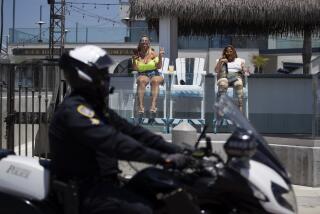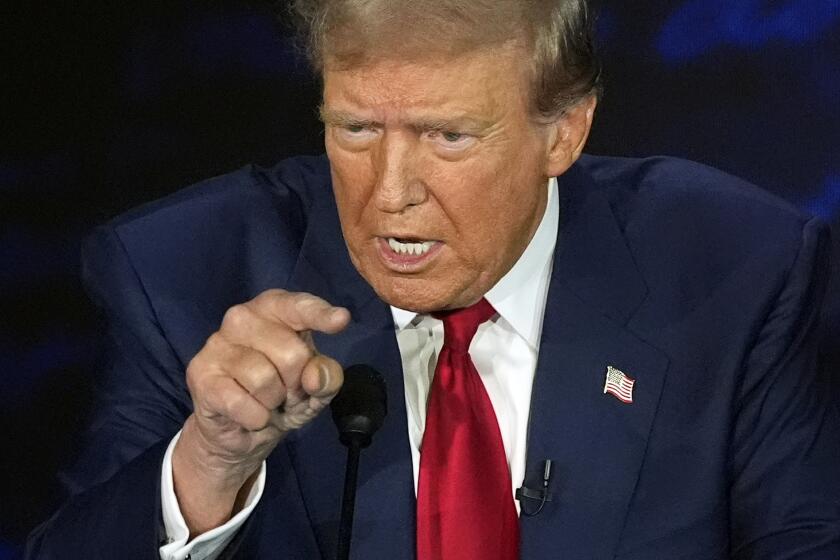The Riots Behind Us, Let the Debates Begin
- Share via
By now, most Angelenos probably feel as if their brains have been stormed by the media. True news junkies, however, have already made room amid the clutter of riot images for the perspectives in news magazines this week.
Time, Newsweek and U.S. News & World Report all came through with gripping photos and massive, largely excellent reportage. More significant than the blow-by-blow coverage of the King verdict and subsequent events, however, is the forum they provided for fresh thinking about how Los Angeles and America got into this mess and how we might dig out.
Some all-too-familiar folks are already charging about in the rubble, waving the placards of their tired old agendas. The average Angeleno, meanwhile, senses a clear need and a once-in-a-lifetime-chance to sweep all the prefabricated thinking and politically correct blather into the dumpsters of history and start afresh.
Politicians won’t be much help. As Newsweek says, “There’s nothing like a horrifying riot to expose the 1992 presidential campaign for what it’s mostly been: an exercise in rhetoric and timidity.”
For the last year, thoughtful magazines have presented disturbing, enlightening, and potentially revolutionary discussions of the interrelated issues of race, justice, crime, economics, education and family. With luck, editors will continue to steer an intellectually honest vanguard of thinkers through the tangled chaos.
The most important insights will likely percolate from the so-called “thought leader” magazines, such as the Atlantic, from open-minded political magazines of various stripes, and from such gutsy African-American publications as Reconstruction and Emerge.
But by turning over their podia this week to some discordant but clear voices within the present cacophony, the news magazines get the debate off to a good start.
Excerpts from the free-for-all:
* David Gergen, in U.S. News, chastises politicians and the media for a “conspiracy of silence, trying not to talk about what is happening to us as a people.
“But we can no longer avoid reality.”
Gergen decries failed policies. But he also points to author Lizbeth B. Schorr’s evidence in the book “Within Our Reach” that “some programs--yes, government programs--actually do work to reduce black poverty.
“The problem is not that we’ve done too much but that we’ve done too little and done it without insisting upon better results.”
* A U.S. News article (“What the LAPD Ought to Try”) tracks the history of policing to the professional reforms that began in the ‘50s and ‘60s. Few cops now believe that crime can be stopped with handcuffs and guns alone, as evidenced by the push for community-based policing in many cities. And as one police training instructor says, citizens know the difference between aggressive policing and abusive policing.
* Newsweek offers an excerpt from Daryl Gates’ forthcoming book, “Chief: My Life in the LAPD.” The chief comes across as typically arrogant but does point out the basic paradox of peoples’ belief that they can have their cops and bash them too:
“The American public needs to grow up . . . The people pass laws to control traffic and pay the police to enforce those laws. Then, when we stop them for a violation, they get mad at us.”
Gates sounds silly when he lists community-oriented policing, which he has resisted, as one of his six ideas for fixing the criminal justice system. But some of his other hard-nosed suggestions will make sense to everyone but anti-police Pollyannas.
For instance, any working cop would agree with him that parole and probation don’t work. “They’re useless,” Gates says. “A recent study by the Rand Corp. determined that within two years, two-thirds of those released in probation commit crimes that lead to their rearrest.”
* Police Chief-designate Willie L. Williams also talks tough in a Time Q&A;: “The African-American community wants strong, tough, honest, fair policing . . . I think that even in the city of Los Angeles, with all its strife, the people say, ‘Hey, wait a minute. These people are robbing and stealing and looting. They are not our community; they are not our friends. They are gang members, or they are hoodlums, and they are bums, and they belong in jail.’ ”
* Time’s most provocative commentary appears in an essay by Lance Morrow that juxtaposes the final Cosby show and the deluge of riot coverage.
“There is no deeper need among the nation’s most deeply needy blacks than perfect fathers, Dr. Huxtables, role models for male children, grown men who will do the first, indispensable thing for children: make them safe and happy. Then teach them how to grow up, how to be intelligent and responsible and how to raise children of their own. Without all that, nothing can be done . . . .
“America makes itself insane with the envies and needs that its self-images create. To have and have not is relative. Last year’s movie ‘Boyz N the Hood’ was set in the same South-Central Los Angeles that was burning in last week’s riots. The characters, the boyz, were supposed to represent the dead-end hopelessness of black ghetto males. And they did. They also lived in relatively pleasant homes and drove customized cars and watched enormous color TV sets in a lifestyle that most of the residents of Kinshasa or Cairo would consider upper-middle class--nearly luxurious. An objective, literal-minded Marxist might wonder what the boyz’ whining was all about. But the terrible American lovelessness and exclusion and self-pity--the fatherlessness, the leaderlessness--gave the boyz a ring of truth. Grievance is comparative. If you feel inferior and hopeless and lost, especially compared with the Big White Other, why then you are . . . . “
Other tidbits:
* Newsweek’s popular “Conventional Wisdom” column gives Los Angeles its symbol of declining fortunes, an arrow pointing downward. As the column explains in its shorthand: “L.A. Lawless. Scary cops, insular whites. So bad, it made New York look good.”
* In a Special Report for Newsweek, Jay Mathews offers an insightful look at California’s deeply rooted fear of crime and the riots’ possible effects on that entrenched phobia. He points out that contrary to some speculation, voting patterns show Simi Valley “differs little from other California suburbs, with residents who see police as a bulwark against urban chaos and crime.”
California’s African-Americans and other minority voters are also tough on crime. But they know better than anyone that the police must not be above justice. Mathews predicts, however, that Proposition F--the city’s police reform amendment--will suffer because of the upheaval.
Upheaval in West Los Angeles and the San Gabriel Valley, writes Mathews, “reminded voters of how far graffiti and gangs have spread. Now the reignited fears are likely to prompt a return to law-and-order politics.”
* Finally, the sense of futility is summed up in the sadly hollow promise Tom Bradley made during his failed 1969 mayoral bid.
As quoted in a Time essay, “The Limits of Black Power,” Bradley says:
“I want to provide a sense of hope for our young people. I want them to be able to look at city hall and know that the system can work . . . I want them to know that we can reshape the structure, that it doesn’t need to be destroyed.”
More to Read
Get the L.A. Times Politics newsletter
Deeply reported insights into legislation, politics and policy from Sacramento, Washington and beyond. In your inbox twice per week.
You may occasionally receive promotional content from the Los Angeles Times.










